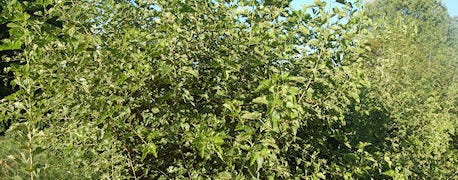
The hot, dry summer was terrible for corn, not so hot for soybeans, and death on lawns, especially if the lawn wasn't shaded. However, the saplings and brush that grows along fence rows appears to be having a good year. Why it grows and landscaping shrubs suffer is one of those mysteries that perhaps we're not supposed to solve.

QUICK FOREST: This brush grew back this year, even with the drought. The best advice is to treat the stumps with pure, undiluted crush killer after cutting it, extension educator Chris Parker says.
One farmer who has brush in an area he cut off last year only to watch it grow back asked Chris Parker, Morgan County Extension ag educator, how to keep it from happening again. Parker says the secret is to use what is called a stump treatment. Otherwise, those kinds of shrub brushes will continue to grow back year after year. Unless you've cut them low, they're too high and too big around to knock down with a normal brush cutter without damaging the blades.
The secret is to cut them at the base of the ground with a pruners or whatever tool it takes, he notes. They can be cut yet this fall, or actually any time during the year, even in winter. Then apply the stump cut treatments. You can use commercial brush killers, or even concentrated Roundup to brush onto the cut surface of each stump, he says.
The secret is to use full strength and not dilute the herbicide. If you use Roundup, don't purchase the ready-to-use type. Instead, get the concentrated type as you would apply on farm fields. Then brush it on each cut surface.
If there's another secret, it's to apply the herbicide as soon as possible after the brush is cut, he says. If you wait a few days, the stump may form a callus over the cut, and it won't absorb the herbicide treatment.
The only advantage of Roundup over some other options is that Roundup does not move in the ground. If it is a fence row, any option should work. If it's next to a garden and you have established plants, say asparagus or strawberries, you may want to opt for the Roundup option to prevent movement within the soil to other root crops.
About the Author(s)
You May Also Like




